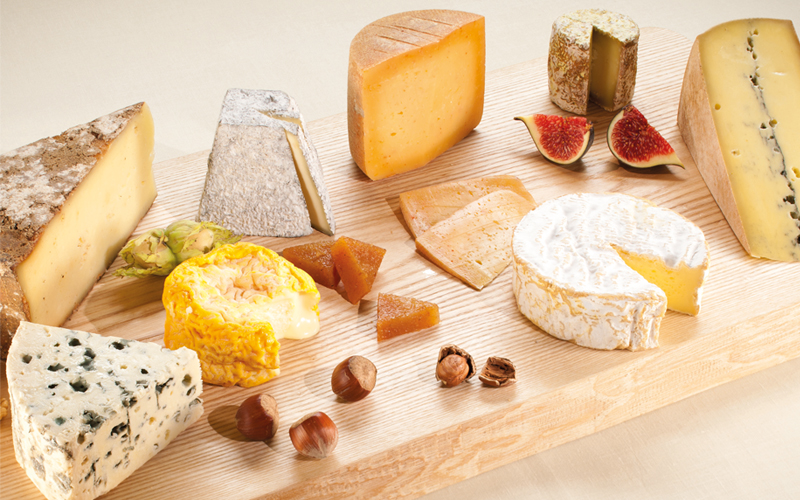The cheese plate – or board as it’s sometimes called – is the perfect way to end a wonderful meal for cheese lovers around the globe. Or, served with wine and crusty bread, it can be a light meal on its own. When paired with a wonderful Champagne or Cabernet, it becomes an unmatched delight for the palate.
In France, a selection of sumptuous cheeses is typically presented after the main course in place of dessert. Love cheese? Creating a cheese plate that is balanced visually and in terms of flavors and textures is a skill that’s easy to learn and always useful.
According to Charles Duque, Director, The French Dairy Board for the Americas, “there’s no such thing as the perfect cheese plate. It’s a matter of personal taste and occasion.”
Duque offers these tips for creating a cheese board with style.
Balance: It’s all about the numbers. Duque (like many interior decorators) likes the power of uneven numbers. He insists on using three, five or seven cheeses in his presentations.
Follow the clock: Position your cheeses on the board and think of them as a clock. Start from the mildest and work your way up to the most intricate (i.e. pungent).
Duque notes with good reason – “If you start with the stinky cheese, you will not be able to taste the more delicate cheeses”.
It’s About Style: Select your cheeses from one of each of the major styles. Washedrind, soft cheese, hard cheese and a pungent blue. Here are some of his favorites:
Washed-Rind: Pont L’Eveque
Pont L’Eveque has buttery and savory flavors, with tangy hints of tangy fruit. Equally enjoyed with Champagne or a post meal apple brandy.
Soft Cheese: Bûche de Luçay
Duque recommends a goat cheese, like Bûche de Luçay from the Loire Valley. Fresh goat cheese is light, tangy, and spreadable; and aged goat cheese (Bûche de Luçay is aged for two months) is slightly crumbly and similar in texture to cheesecake.
Hard Cheese: Mimolette
Mimolette is nutty with hints of butterscotch, like an aged Gouda. It’s very firm but not overly salty like Parmigiano-Reggiano, and its bright orange color also makes it stand out.
Blue: Roquefort
The classic blue cheese is sharp and delightfully pungent with a slightly dry texture. A great addition for those who want a true blue.
The Company You Keep: Baguette or cracker; hand-to-mouth? It’s totally up to you. Duque warns the baguette or cracker should be neutral. Do not put a delicate cheese on something so savory that it will mask the flavor of the cheese. Keep the crackers light and crisp, the baguettes should be sliced and then sliced again. You want to taste the cheese not the bread.
Slice it in Style: Cheeses deserve worthy companions both alongside and for serving. For a truly French experience try the Laguiole Jean Neron Cheese knives. These elegant stainless steel - wood handled Laguiole knives come from the Massif Central region of France – specifically the “knife city” of Thiers where 70% of French cutting tool production comes from.
Add a bit of the Sweet Stuff: Finally, a little bit of sweetness to balance it all out is always a good addition, especially if you are going the French route and serving the cheeses Après le diner. Instead of the usual fruit and nut, splurge on a beautiful Pate du Fruit or this delightfully light and creamy lavender Honey by Maison Peltier.
cheesesoffrance.com
FRENCH CHEESE BOARD STARS
Fourme d’Ambert: One of the mildest blue cheeses, Fourme d’Ambert is creamy with a delicate, fruity flavor, making it an ideal addition to salads or simply with bread or pear slices. Enjoy Fourme d’Ambert with fruity red or sweet dessert wines.
Livarot: With a pungent, earthy aroma, Livarot is hard to ignore. Its full, spicy flavor can also include a tongue-biting tanginess. Spread on crusty bread or as a dessert with apples, grapes and pears, Livarot goes well with a medium-bodied white wine, hard cider, or apple brandy.
Mimolette: The sharp, nutty, fruity taste of Mimolette also includes sweet hints of butterscotch. Its brilliant orange color makes it the focus of any cheese platter. Try Mimolette with a rustic red wine or ale.
St. André: This decadent cheese is buttery, smooth and mild. Spread it on bread or crackers and enjoy with Champagne. Or, try it for a delightful dessert with fresh fruit.
Bûche de Luçay: This wonderful goat’s milk cheese, from Poitou in the Loire Valley, comes to us in handcrafted wooden crates containing two, four-pound logs of the most exquisite Lucay. Each Bûche de Luçay is aged for two months, during which time it develops a hard, edible crust complete with a bloomy white mold coating.






